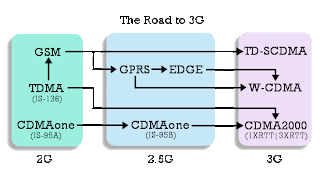3G Technology
Cell Structure
Macro Cells, Micro Cells, and Pico Cells
The 3G network might be divided up in hierarchical fashion:
* Macro cell - the area of largest coverage, e.g., an entire city.
* Micro cell - the area of intermediate coverage, e.g., a city centre.
* Pico cell - the area of smallest coverage, e.g., a "hot spot" in a hotel or airport.
* Micro cell - the area of intermediate coverage, e.g., a city centre.
* Pico cell - the area of smallest coverage, e.g., a "hot spot" in a hotel or airport.
3G Standards
The 3G standard was created by the International Telecommunication Union (ITU) and is called IMT-2000. The aim of IMT-2000 is to harmonize worldwide 3G systems to provide global roaming. However, as was explained in the introduction to this section, harmonizing so many different standards proved extremely difficult. As a result, what we have been left with is five different standards grouped together under the IMT-2000 label:
* W-CDMA
* CDMA2000
* TD-CDMA/TD-SCDMA
* DECT
* UWC-136
At this point, the definition of what is and what isn't "3G" becomes somewhat murky. Of these five standards, only three allow full network coverage over macro cells, micro cells and pico cells and can thus be considered as full 3G solutions: W-CDMA, CDMA2000, and TD-SCDMA. Of the remainder, DECT is used for those cordless phones you have in the house, and could be used for 3G short-range "hot-spots" (hence, it could be considered as being "part of a 3G network"), but it does not allow full network coverage so is not considered further here. And UWC-136 is another name for EDGE which is generally considered to be a 2.5G solution and was considered in the previous section.
3G Spectrum
When you read about radio spectrum this means a range of radio frequencies. The bandwidth of a radio signal is defined as being the difference between the upper and lower frequencies of the signal. For example, in the case of a voice signal having a minimum frequency of 300 hertz (Hz) and a maximum frequency of 3,300 Hz, the bandwidth is 3,000 Hz (3 KHz).
The amount of bandwidth needed for 3G services could be as much as 15-20 MHz. Compare this with the bandwidth of 30-200 KHz used for current 2G communication and you can see that there is as much as a 500-fold increase in the amount of bandwidth required. Now you can appreciate why radio spectrum has become such a precious and scarce resource in the information age - everybody from television broadcasters to the military wants spectrum, and it is in short supply. Michael Powell, the chairman of the U.S. Federal Communications Commission (FCC), has suggested that spectrum demand "is going to forever outstrip supply". The telecoms operators have had to buy 3G spectrum from governments around the world, and those governments - realising that they own a precious, valuable resource - have sought to sell that spectrum at the highest possible price.
Radio spectrum is often organised (and sold) as paired spectrum - a bit of spectrum in a lower frequency band, and a bit of spectrum in an upper frequency band (see the section on 3G Technology for an explanation of paired spectrum). Paired spectrum is often specified in a form like "2x15MHz" meaning 15MHz in a lower band and 15MHz in an upper band. This technique of two users talking to each other on two separate frequencies is called Frequency Division Duplex, or FDD (see the section on 3G Technology for an explanation of FDD). W-CDMA is an FDD technique (i.e., it requires paired spectrum) whereas TD-CDMA is a TDD technique (i.e., it can use unpaired spectrum).




No comments:
Post a Comment